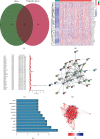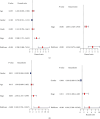A Novel Expression Signature from the Perspective of Mesenchymal-Epithelial Transition for Hepatocellular Carcinoma with Regard to Prognosis, Clinicopathological Features, Immune Cell Infiltration, Chemotherapeutic Efficacy, and Immunosuppressive Molecules
- PMID: 34367283
- PMCID: PMC8342179
- DOI: 10.1155/2021/5033416
A Novel Expression Signature from the Perspective of Mesenchymal-Epithelial Transition for Hepatocellular Carcinoma with Regard to Prognosis, Clinicopathological Features, Immune Cell Infiltration, Chemotherapeutic Efficacy, and Immunosuppressive Molecules
Abstract
Purpose: Mesenchymal-epithelial transition (MET), a reverse biological process to epithelial-mesenchymal transition (EMT), is involved in tumor metastasis and invasion. However, the role of MET-related genes (MRGs) in hepatocellular carcinoma (HCC) prognosis remains unclear.
Methods: In this research, we obtained MRGs data and clinical information from public databases. In the TCGA dataset, a prognostic signature for HCC was constructed by the least absolute shrinkage and selection operator (LASSO) method and externally verified using the ICGC dataset.
Results: There were 148 differentially expressed MRGs (DEMRGs), out of which 37 MRGs were found associated with overall survival (OS) in the univariate Cox analysis. A novel signature integrating of 5 MRGs was constructed, which split patients into high- and low-risk groups. Kaplan-Meier analysis revealed that high-risk patients had unfavorable OS than those low-risk counterparts. Receiver operating characteristic curve (ROC) showed great performance of this signature in predictive ability. Multivariate Cox analysis confirmed that this signature could independently predict HCC prognosis. The analysis of immune cell infiltration demonstrated that immune status varied differently between high- and low-risk groups. The analysis of clinicopathological characteristics suggested that tumor grade, clinical stage, and T stage were different between risk groups. The analysis between this signature and chemotherapeutic efficacy and immunosuppressive molecules indicated that this signature could serve as a promising predictor.
Conclusions: In conclusion, we constructed and verified a novel signature from the perspective of MET, which was significantly associated with HCC prognosis, clinicopathological features, immune status, chemotherapeutic efficacy, and immunosuppressive biomarkers.
Copyright © 2021 Lijun Xu and Qing Zheng.
Conflict of interest statement
The authors declare that they have no conflicts of interest.
Figures








Similar articles
-
Development and validation of a robust epithelial-mesenchymal transition (EMT)-related prognostic signature for hepatocellular carcinoma.Clin Res Hepatol Gastroenterol. 2021 Sep;45(5):101587. doi: 10.1016/j.clinre.2020.101587. Epub 2021 Mar 1. Clin Res Hepatol Gastroenterol. 2021. PMID: 33662631
-
Combination of ferroptosis and pyroptosis to construct a prognostic classifier and predict immune landscape, chemotherapeutic efficacy and immunosuppressive molecules in hepatocellular carcinoma.BMC Cancer. 2022 Mar 2;22(1):229. doi: 10.1186/s12885-022-09301-0. BMC Cancer. 2022. PMID: 35236323 Free PMC article.
-
A novel epithelial-mesenchymal transition gene signature for the immune status and prognosis of hepatocellular carcinoma.Hepatol Int. 2022 Aug;16(4):906-917. doi: 10.1007/s12072-022-10354-3. Epub 2022 Jun 14. Hepatol Int. 2022. PMID: 35699863 Free PMC article.
-
An Inflammatory Response-Related Gene Signature Can Impact the Immune Status and Predict the Prognosis of Hepatocellular Carcinoma.Front Oncol. 2021 Mar 22;11:644416. doi: 10.3389/fonc.2021.644416. eCollection 2021. Front Oncol. 2021. PMID: 33828988 Free PMC article.
-
Mining Prognostic Biomarkers of Hepatocellular Carcinoma Based on Immune-Associated Genes.DNA Cell Biol. 2020 Apr;39(4):499-512. doi: 10.1089/dna.2019.5099. Epub 2020 Feb 18. DNA Cell Biol. 2020. PMID: 32069130 Review.
Cited by
-
Retinoblastoma-Binding Protein 5 Regulates H3K4 Methylation Modification to Inhibit the Proliferation of Melanoma Cells by Inactivating the Wnt/β-Catenin and Epithelial-Mesenchymal Transition Pathways.J Oncol. 2023 Feb 21;2023:5093941. doi: 10.1155/2023/5093941. eCollection 2023. J Oncol. 2023. PMID: 36866240 Free PMC article.
-
The KDM6A-SPARCL1 axis blocks metastasis and regulates the tumour microenvironment of gastrointestinal stromal tumours by inhibiting the nuclear translocation of p65.Br J Cancer. 2022 Jun;126(10):1457-1469. doi: 10.1038/s41416-022-01728-3. Epub 2022 Feb 8. Br J Cancer. 2022. PMID: 35136209 Free PMC article.
References
LinkOut - more resources
Full Text Sources
Miscellaneous

